EURASIA
Central Asia takes its geopolitical significance to a new level


Central Asia takes its geopolitical significance to a new level

“The present situation enhances the importance of the entire Central Asian region, and there is a good chance for this region to become a bridge between East and West”
Viktor Orbán
FOREWORD
The Great Game – Levente Horváth GEURASIA
2-3.
Constitutional reform in Uzbekistan – Meszár Tárik
4. Kazakhstan: Central Asia’s next pilot democracy – Mátyás Kohán
6–7.
Turkic countries link the East and the West: interview with Ambassador János Hóvári – Anita Bojtos
THE ECONOMICS OF GEOGRAPHY
8-9.
China-Central Asia Summit: long game paying off – Javier M. Piedra
10. Uzbekistan on the New Silk Road – Bálint Ráczkevi
NEW SUSTAINABLE ECONOMICS
12-13.
Overcoming challenges through dialogue: interview with Ambassador Zhanibek Abdrashov – Mariann Őry
15. Build back greener – Joakim Scheffer
NEW AGE – NEW ROAD
16-17.
The dawn of a new world order – Norbert Csizmadia
18. More than just a smart city
2T2C: TALENT, TECHNOLOGY, CAPITAL, COGNITION 20-21.
Kazakhstan’s leading multidisciplinary university
CULTURE AND INNOVATION
22-23.
From Tashkent to Astana
24-25.
A picturesque bit of the Silk Road – Kyrgyzstan
– Sándor Seremet
26. Book reviews
RHYMES IN HISTORY
28-29.
Kazakhstan’s state symbols – Szabolcs Veres
ANCIENT KNOWLEDGE IN A MODERN WORLD
30-31.
How Kazakhstan evaluates its own past – András Kosztur
Central Asia has been playing a prominent bridging role in world history, yet it usually receives little attention. Great migratory movements took place at the turn of the 3rd and 2nd millennia BC, but the East Asian peoples who later reached Europe also passed through Central Asia. Central Asia was also the link between ancient and later civilisations, so important routes of the ancient Silk Road passed through the region, and many significant stations were established. Throughout history, Central Asia has been the meeting place for the ancient knowledge of different cultures and civilisations and later for religions, technologies and different ways of thinking.
In the Middle Ages, with the establishment of maritime routes, the role of the overland Silk Road, and hence Central Asia, was relegated to the background, but in the 13th century, the Mongol conquests again focused on the occupation of Central Asian territories, through which they reached the Middle East and then Europe.
By the mid-19th century, it had become a geopolitical arena of great powers, with Britain and the Russian Empire competing to dominate the region in „The Great Game”. At the same time, several Western and Russian geographic explorers travelled to the region to map it, but in the process, made great discoveries, such as the Hungarian explorers Béla Széchenyi, Lajos Lóczy and Aurél Stein, who „rediscovered” the ancient Silk Road during their expeditions. „The Great Game” lasted until the early 20th century, and the region eventually became part of the Soviet Union until the 1990s, when the Central Asian states gained their independence.
In the 21st century, this vast region has once again become important in international politics, with several significant powers establishing joint international cooperation with the Central Asian countries: in 2001, they formed the Shanghai Coopera-
Levente Horváth, Ph.D., Director of the Eurasia Center, Editor-in-Chief of the Eurasia Magazine
tion Organisation with China and Russia, and in 2009 established the Organisation of Turkic States with Turkey, but they have also expressed their intention to join the Eurasian Economic Union, created by Russia. They also play a prominent role in the Belt and Road Initiative in the framework of the China-Central Asia Summit.
In May, we visited Uzbekistan, Kyrgyzstan and Kazakhstan on a trip to Central Asia, where the countries’ openness and economic development were evident. European countries, including Hungary, are increasingly focusing on Central Asia, and there is a growing international presence in the region.
As we can see, Central Asia has historically always been important for the great powers and has become a region of particular importance for the 21st century, but now as independent states, they can decide of their own free will how to participate in international organisations. For the time being, however, it appears that emerging Central Asia has joined the institutions of Asian countries, promoting Eurasian connectivity and peaceful cooperation based on mutual respect.
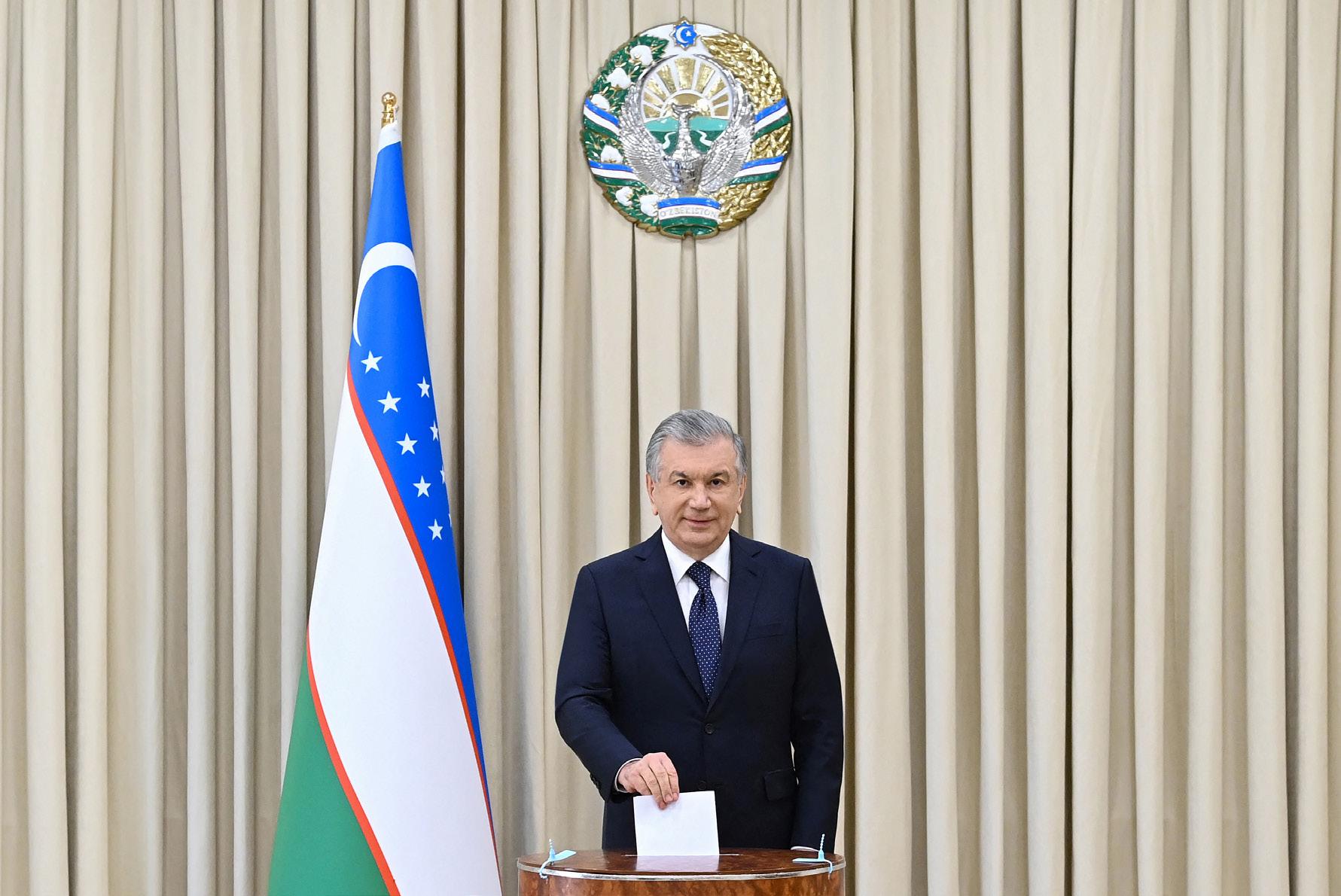 by Meszár Tárik
by Meszár Tárik
ON MARCH 10, THE LOWER HOUSE OF THE UZBEK PARLIAMENT, THE LEGISLATIVE CHAMBER, SCHEDULED A REFERENDUM ON THE CONSTITUTIONAL AMENDMENT FOR APRIL 30, WHICH WAS SUPPORTED BY 132 DEPUTIES. VOTERS HAD TO DECIDE WHETHER TO ACCEPT THE DRAFT CONSTITUTIONAL AMENDMENT TO THE CURRENT CONSTITUTION. THE MODIFICATIONS WERE APPROVED IN THE REFERENDUM WITH MORE THAN 90.21% APPROVAL.
■ the extension of the presidential term from 5 to 7 years;
■ the declaration that Uzbekistan is a “legal, social and secular” state (in addition to the current terms “sovereign” and “democratic”);
■ “nullify” Uzbek President Shavkat Mirziyoyev’s previous and current terms, allowing him to run for another two consecutive terms after 2026;
■ Uzbek citizens will receive better social and legal protection;
■ Strengthen the rights and protection of persons accused of crimes for which they have not yet been convicted and prohibit extradition and the death penalty;
■ guarantee free primary health care for citizens, including emergency care;
■ codifying the commitment to environmental protection and sustainable development;
■ strengthening the role of parliament and political parties;
■ the establishment of the Constitutional Court.
The referendum was interpreted by many as a consolidation and expansion of Mirziyoyev’s power, allowing him to remain at the head of the country until 2040. Regardless of this, Mirziyoyev was praised by many for making his country an open economy, improving relations with the West and limiting the power of the security services, whose dominance in recent decades had turned the country of 35 million people into a police state.
It is important to note that the referendum also served to present Uzbekistan’s strategic direction for further reforms of society and the state, which had a positive impact on Uzbekistan’s foreign policy, especially in the Central Asian region.

The recent referendum on April 30 was the third referendum in the history of independent Uzbekistan. Although it is unlikely that Tashkent’s Western allies will approve the expansion of presidential powers, the risk to Uzbekistan is minimal, given the West’s interest in gaining support from former Soviet states to isolate Russia amid the ongoing conflict in Ukraine.
On June 9, Mirziyoyev was reelected with 87.05% of the vote. More than 15 million voters participated in the elections.
The author is a researcher at Eurasia Center
 by Mátyás Kohán
by Mátyás Kohán
WHILE THE U.S. TRIES TO MAKE THE CONFLICT OF DEMOCRACIES AND DICTATORSHIPS COME TO A HEAD, KAZAKHSTAN IS TRYING TO HAVE ITS PLOV AND EAT IT, TOO – WITH GREAT SUCCESS SO FAR.
It’s easy for those with three centuries of somewhat-democratic tradition to imagine what democracy looks like. It’s possible, if tougher, for those who possessed some semblance of sovereignty in the course of history, too. The ones who have a hard time are the young nations, which constitute, in fact, most of the world – and chief among them are the nations that were consolidated within the wedlock of the erstwhile Soviet Union.
Kazakhstan stands out as a singular example in its region: a state that could, without significant historical traditions to harken back to, guarantee the trifecta of stability, gradual economic growth for large swaths of the population, and incremental democratization. This process reached a pivotal moment in March of this year, when the country held arguably, the most democratic legislative election of its existence. Their achievements this year are rather impressive: they have secured the most realistic turnout in the history of Kazakhstan, the most positive OSCE observers’ report to date, and the inclusion of two systemic opposition parties in its legislative work without losing its trademark stability.
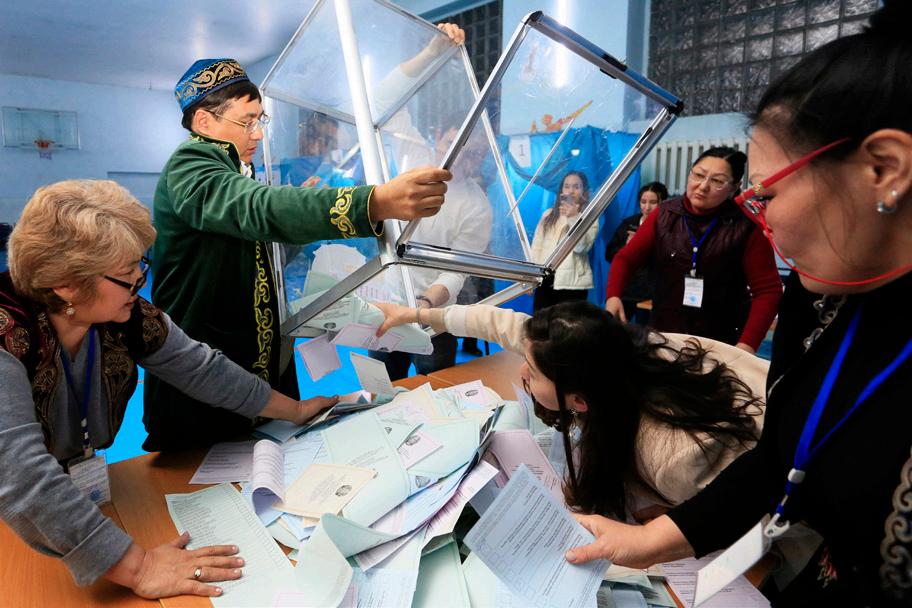
Without the emergence of a political nation, bilingual, bicultural, and tribal Kazakhstan provides ample societal fault lines for bad-faith actors to exploit. And the foreign policy challenges that modern Kazakhstan faces are everything but trivial. A country with a trade dependence of about 70 per cent on Russia, a Russian minority of 15 per cent, the world’s largest land border with Russia as well as one with China, needs to survive the U.S.-China cold war and dodge the threats of secondary sanctions and of the Russian invasion. Alibek Kuantyrov, Kazakhstan’s Minister of National Economy, made the stakes painfully clear in an address to foreign journalists before the election when defending his country’s anti-sanctions stance: “We have to act in the interest of our people, our nation, and our territorial integrity.”
This is a connectivity-oriented nation’s existential battle – where democratic legitimacy is the weapon of choice that will allow the country to have its plov and eat it, too.
The author is a foreign policy journalist

Photos: Róbert Hegedüs
HUNGARY HAS BEEN AN OBSERVER MEMBER OF THE ORGANIZATION OF TURKIC STATES (OTS) SINCE AUTUMN 2018. WE ASKED AMBASSADOR JÁNOS HÓVÁRI, HEAD OF THE HUNGARIAN REPRESENTATIVE OFFICE, ESTABLISHED IN 2019, ABOUT THE CURRENT SITUATION OF THE ORGANISATION AND THE BENEFITS OF HUNGARY’S OBSERVER MEMBERSHIP.

– Has the geopolitical role of the OTS changed in the last year due to the Russian-Ukrainian conflict?











The Russian-Ukrainian war has increased the value of the OTS both in international relations and in the world economy. Ankara has been an active and useful mediator between Moscow and Kiev since the beginning of the war. The other OTS states are also pro-peace and are in contact with both sides. In addition, the war has reduced the flow of trade routes between Western Europe and Western China and has valorised the so-called Middle Corridor. The development of this route is important not only for the Turkic world, but also for China, as it is part of the Belt and Road Initiative - and for the European Union.
– What do you consider to be the most important areas of cooperation between OTS and Hungary?

High-level political consultations characterised by a deep mutual trust. These form the basis of the economic, development, innovation and educational cooperation that is the practical essence of the philosophy of OTS.
The Cooperation Council of Turkic Speaking States - or Turkic Council for short - was established in 2009 in Nakhchivan, Azerbaijan. It was founded by Azerbaijan, Kazakhstan, Kyrgyzstan and Turkey, with Uzbekistan joining in 2019. Their name was changed to the Organisation of Turkic States (OTS) in 2021, reflecting the increasing institutionalisation of the organisation. Its General Secretariat is based in Istanbul, where diplomats from member states serve, and its Secretary General is currently Kubanychbek Omuraliev, a Kyrgyz diplomat.






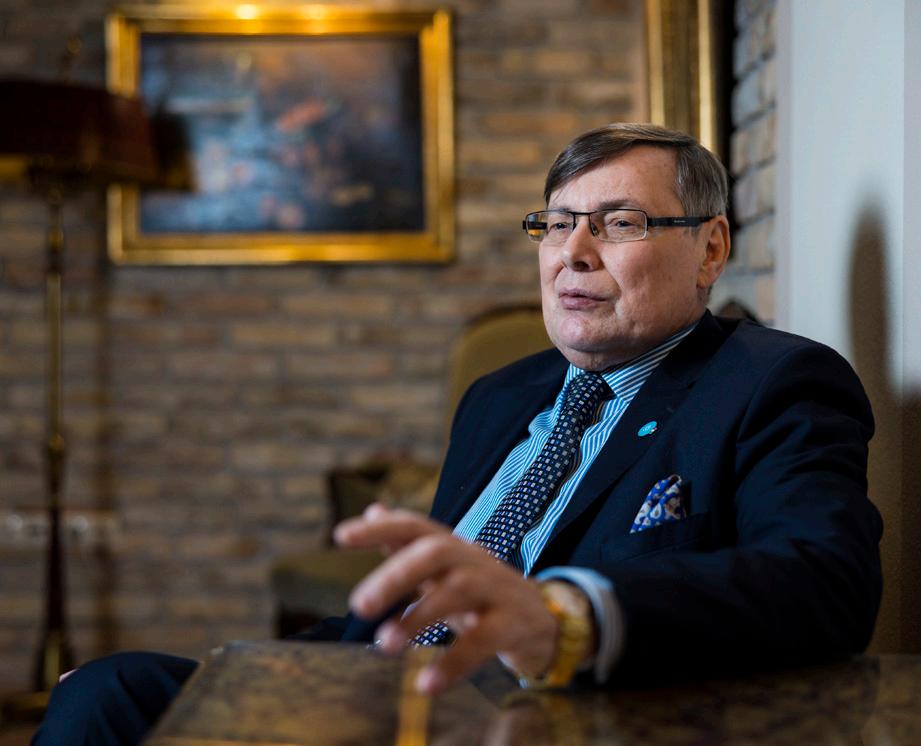



How equal is this cooperation?
The OTS head of state see Hungary as an important European link, a country distantly related to them, whose representatives at the negotiating table in Brussels are aware of the Turkic world’s most pressing concerns and visions for their future. The Turkic countries are open to all parts of the world: China and Russia are their most important partners because of their geographical location. The United States is also paying attention to them.
The author is a historian
The restoration of security in the Black Sea is not only a matter for the coastal states, but also an issue of world trade importance.
Uzbek President Shavkat Mirziyoyev, Tajik President Emomali Rahmon, Kazakh President President KassymJomart Tokayev, Chinese President Xi Jinping, Kyrgyz President President Sadyr Japarov and Turkmen President Serdar Berdymukhamedov
PRESIDENTS XI JINPING OF CHINA, KASSYM-JOMART TOKAYEV OF KAZAKHSTAN, SADYR JAPAROV OF KYRGYZSTAN, EMOMALI RAHMON OF TAJIKISTAN, GURBANGULY BERDIMUHAMEDOV OF TURKMENISTAN AND SHAVKAT MIRZIYOYEV OF UZBEKISTAN MET IN PERSON FOR THE FIRST TIME ON MAY 18-19. THEY ATTENDED THE FIRST CHINA-CENTRAL ASIA SUMMIT IN XIAN, SHAANXI PROVINCE, CHINA.

be sure, it represented the beginning of an even deeper collaboration among the countries rather than, as some might assume, just one more diplomatic engagement with little significance.
The summit reaffirmed that regional multilateralism is full-bodied and that Middle Eurasia has created a working collective diplomatic platform with downstream delivery networks.
Over the past years, the six countries have materialised their respective interests for closer integration, meeting separately and together on multiple occasions on a wide spectrum of socio-developmental and sticky geo-economic issues, including resolution of boundary disputes.
The Central Asian and Chinese governments approved 3.72 billion USD in regional grants, signed 54 major multilateral agreements, created 19 new regional platforms and signed a further 9 multilateral cooperation documents, according to the Silk Road Briefing.




Optimism is in the air throughout the region despite tensions in the neighborhood. To underscore the seriousness of developments, prior to the summit, President Rahmon has visited Kazakhstan and President Mirziyoyev has traveled to Tajikistan, Kazakhstan and elsewhere. Presidents Japarov and Tokayev are in constant contact. Presidents Rahmon and Japarov are working through bilateral issues.
Besides advancing regional integration, after all is said and done, the China-Central Asia Summit may encourage Brussels and Washington to consider a foreign policy anchored more in realism and common sense than in moralising and unhealthy gamesmanship.
The full version of this article was originally published by Asia Times and is republished with the permission of the media outlet

 by Bálint Ráczkevi
by Bálint Ráczkevi
CENTRAL ASIA’S ECONOMIC AND GEOPOLITICAL ROLE FOR EUROPE HAS INCREASED SIGNIFICANTLY IN THE LAST TWO DECADES. THE REGION’S FIVE COUNTRIES OWE THIS NOT ONLY TO THEIR FORTUNATE GEOGRAPHICAL LOCATION BUT ALSO TO THEIR DYNAMIC ECONOMIC DEVELOPMENT. UZBEKISTAN, ALONG WITH KAZAKHSTAN, IS A LEADING PLAYER IN THE CENTRAL ASIAN ECONOMY
After the break-up of the Soviet Union, Central Asia emerged as a new geopolitical region in the world economy. This region traditionally includes five former Soviet republics, namely Kazakhstan, Uzbekistan, Tajikistan, Turkmenistan and Kyrgyzstan, which are rich in raw materials and energy resources such as oil, natural gas, coal and uranium. Central Asia is now an important transport hub in the centre of the Eurasian continent, as the Belt and Road (BRI) linking China to Europe passes through the region.
Since taking office in 2016, Uzbek President Shavkat Mirziyoyev has pursued an open foreign policy, and his reforms have led to social and governmental modernisation and economic development.
The government’s proposal to become an observer state of the Russian-led Eurasian Economic Union was approved by a majority in parliament 2020. Still, accession is not yet on the agenda. Mirziyoyev prefers the Chinese-dominated Shanghai
Cooperation Organisation (SCO), which Uzbekistan joined when it was founded in 2001. Since 1991, large Chinese corporations have invested billions of dollars in Uzbekistan, mainly in transport infrastructure and telecommunications. With the announcement of the BRI, investment has been given a new boost in logistics.
Since 2018, Tashkent has been a member of the Organisation of Turkic States (OTS), whose member states are resource-rich and economically open but need to develop their infrastructure.
The author is a student at Budapest Metropolitan University (METU)
“The countries of Central Asia, due to their geographical location and natural resources, are increasingly becoming the focus of great power games.”Khiva, Uzbekistan is located along the ancient Silk Road Photos: iStock


IN THE CAPITAL OF KAZAKHSTAN, TOPICAL ISSUES ON THE INTERNATIONAL AGENDA WERE DISCUSSED AT THE ASTANA INTERNATIONAL FORUM IN JUNE. WE DISCUSSED THE COUNTRY’S INITIATIVES WITH KAZAKHSTAN’S AMBASSADOR TO HUNGARY, ZHANIBEK ABDRASHOV.
– What were the main topics of this year’s forum?
The Astana International Forum opened its doors to its distinguished guests for the first time since 2019. Among them were the Emir of Qatar, the President of Kyrgyzstan, the Chairman of the Presidency of Bosnia and Herzegovina and the Prime Minister of Uzbekistan. The theme of this year’s Forum was „Overcoming Challenges through Dialogue: Towards Cooperation, Development and Progress”. We are confident that the Astana International Forum and the decisions that it adopted will foster greater engagement at a time when we need it more than ever - at a time of unprecedented geopolitical tension.
– What initiatives has Kazakhstan proposed? The president of Kazakhstan proposed reform of the UN Security Council, so that the voices of the middle powers in the Council would be heard more forcefully. As before, our country makes every effort for nuclear disarmament and is committed to the Treaty on the Non-Proliferation of Nuclear Weapons. Kazakhstan is making active efforts to end the civil war in the Syria. Since 2017, Astana has been hosting peace talks on the issue. In addition, Kazakhstan is actively involved in overcoming the humanitarian crisis and in the development of food security in Afghanistan.
– How will Kazakhstan implement its initiatives? Kazakhstan will make every effort to support friendly relations with our global and regional partners. Kazakhstan is determined to deepen and expand cooperation with the countries of Central Asia. At the same time, it should be noted that Kazakhstan is an active participant in the Belt and Road Initiative, which is an important mechanism for strengthening interstate relations in the Eurasian region.
– Were the issues of developing a green economy discussed at the Forum?
To prevent an environmental catastrophe, Kazakhstan calls for allocation of more resources to the International Fund for Saving the Aral Sea. Water and climate change are closely linked. Central Asia is a region where water security can only be achieved through close cooperation and effectively selected joint measures of the whole interna-
tional community. To discuss these and other issues related to climate in the region, the President of Kazakhstan Kassym-Jomart Tokayev proposed to establish a project office of Central Asian countries in Almaty and to hold Regional Climate Summit in Kazakhstan in 2026 under the aegis of UN and other international organisations.
The author is managing editor of Eurasia Magazine

The development of a green economy is relevant for the entire Central Asian region.



 by Joakim Scheffer
by Joakim Scheffer
BAKU IS MAKING ENORMOUS EFFORTS TO REBUILD THE KARABAKH REGION FULLY SUSTAINABLE. THE SUCCESS OF THE RECONSTRUCTION PROCESS IS AS IMPORTANT FOR THE EUROPEAN UNION AS IT IS FOR AZERBAIJAN, GIVEN THAT THE SOUTH CAUCASUS STATE HAS EMERGED AS A KEY PLAYER IN THE EU’S ENERGY SECURITY.
Azerbaijan laid out an ambitious plan to rebuild the war-torn region of Karabakh. The reconstruction process immediately started after the 44-day war back at the end of 2020. In addition to a large number of infrastructure investments, Baku has made the green rebuilding of the region one of its main objectives taking advantage of the vast alternative energy sources that Karabakh has to offer.
In the past months, there have been enormous efforts to boost energy production in the area for the upcoming years. For example, in February 2021, just three months after the ceasefire agreement was reached, a medium-sized hydropower plant was reopened in the Lachin region. This was followed by the reopening of two medium-sized plants in the Terter region, while another two are being constructed on the Araz River in cooperation with Iran. The power plants are now expected to start producing energy in 2024: output will be shared equally between Tehran and Baku.
Besides the hydropower plants, Baku is also planning to build wind and solar energy facilities. The government announced in September 2021 that the whole region will be transformed into a “green energy zone”.
“The more energy we can produce from renewable sources, the more gas and oil we can export to European countries,” said Araz Imanov, a special representative of the Azerbaijani President for the Karabakh region. Therefore it’s not a surprise that the EU as a whole – and some Member States separately – support the reconstruction process. Although there is still much to do – for example, demining the region, which is an incredibly difficult task –it is already clear that Azerbaijan is becoming an increasingly important country for the EU’s energy security.
The author is editor of Eurasia Magazine
Azerbaijani President Ilham Aliyev in Lachin Source: AFP/Anadolu Agency, Presidency of AzerbaijanChina has offered to this long-ignored continent a path towards substantial change.



THE THREE MOST IMPORTANT “PASSWORDS” OF OUR TIME WILL BE INTERCONNECTIVITY, COMPLEXITY AND SUSTAINABILITY. IF WE WANT TO WIN THE ERA, WE NEED TO USE ALL THREE TOGETHER.
We live in an age of networks and fusion. Modern life is unthinkable without networks. A special feature of networks is that each of them has a set of priority nodes with considerably more connections than the others. These nodes can be plotted spatially and represented on a map. Technological progress has revalued the importance of geography, which helps to reveal the central nodes and patterns of air transport, knowledge, university cooperation.
In addition to geographical nodes, spatial flows are also becoming increasingly important. Manuel Castells argues that instead of the previously established geographical approach of “ space of places”, the “space of flows” approach to real processes is becoming justified. At the same time, the international economy is changing unevenly, meaning that geographical differentiation is more pronounced than ever.
As Parag Khanna puts it, competitive interconnectivity is the most important geopolitical driver of our time. Thus, by looking at spatial morphology, interconnectivity has become a new world para-

A COMPLEX SPATIAL STRUCTURE IS TAKING SHAPE, IN WHICH THE GLOBAL ECONOMY CAN BE SEEN AS MORE OF A MULTIPOLAR SYSTEM
digm, and our existing maps can be expanded to include the symbols of transmission lines, highways, rail networks, internet cables and aeroplane routes – symbols of a global network society. According to Khanna, the changing nature of geopolitical competition is complemented and transformed into a struggle for the interconnectivity of supply systems.
The author is a geographer and Chairman of the Board of Trustees of the Pallas Athene Domus Meriti Foundation and the John von Neumann University Foundation
The inauguration of Turkmenistan’s first smart city, Arkadag, was held in late June. The city pays tribute to the country’s former leader Gurbanguly Berdimuhamedov, a total of 3.3 billion USD has already been spent on construction, and another 1.5 billion USD is planned.


There are 336 modern buildings, including multi-storey residential buildings, public, educational, medical and cultural facilities, and sports facilities
were built. The smart city uses sustainable technologies to provide electricity and high-speed communications.
President of Turkmenistan Serdar Berdimuhamedov attended the inauguration, with thousands of public representatives and guests from many countries. The large-scale celebration included traditional choreographies, musicals, and a parade.
 Photos: AFP, Natalia Kolesnikova
Photos: AFP, Natalia Kolesnikova

ter’s Degree – Doctoral Degree, PhD – MBA/EMBA-Advanced Training. Today, about 20,000 students from Kazakhstan and 25 countries study at the university. Training is conducted in more than 260 educational programmes, and a European-style Diploma Diploma Supplement is issued.
ENU has 13 faculties, a military department, a college, 31 research institutes, a School of professional and continuing education, a Nuclear Technology Park, and a number of cultural and educational centres.
L.N.GUMILYOV EURASIAN NATIONAL UNIVERSITY, THE LEADING MULTIDISCIPLINARY UNIVERSITY IN KAZAKHSTAN, PROVIDES HIGH-QUALITY EDUCATION AND MAKES A GREAT CONTRIBUTION TO THE DEVELOPMENT OF THE COUNTRY’S INTELLECTUAL AND ECONOMIC POTENTIAL.
The university increases its competitiveness and demonstrates great progress in the international educational market.
In 2022, ENU was awarded the status of a research university, which opens up new opportunities for the university to develop in the scientific field. ENU provides a high-quality cycle of continuing education: College - Bachelor’s degree – Mas-
The university publishes 18 scientific journals, 3 of which are included in the international Web of Science Core Collection database: “Eurasian Journal of Mathematical and Computer Applications”, “Eurasian Mathematical Journal”, “Eurasian Journal of Physics and Functional Materials”.
Student life is actively developing at the university. There are more than 60 student organizations operating in different directions. The university has its own student theatre, orchestra, dance school, vocal and instrumental ensemble, and so on.
Recognizing its central role in international education and research, ENU offers favourable conditions for international students through the “Welcome to ENU” program for incoming exchange students with free tuition and accommodation fee waiver. Moreover, ENU has recently announced its own scholarships for the international students “Kultegin” and “Gumilyov” that helps to support talented youth from all over the world.
THE UNIVERSITY CONDUCTS RESEARCH ON SIX RESEARCH AND EDUCATIONAL CLUSTERS:

Physical Sciences and Nuclear technologies
Mathematics and Information technologies
Social and Humanitarian sciences
Chemistry and Earth Sciences
Biology, biomedicine and biotechnology
Engineering
Uzbekistan:
Tashkent-Samarkand-Tashkent-Andijan


Kyrgyzstan: Osh-Bishkek






Kazakhstan:
Almaty-Astana-Karaganda-Astana








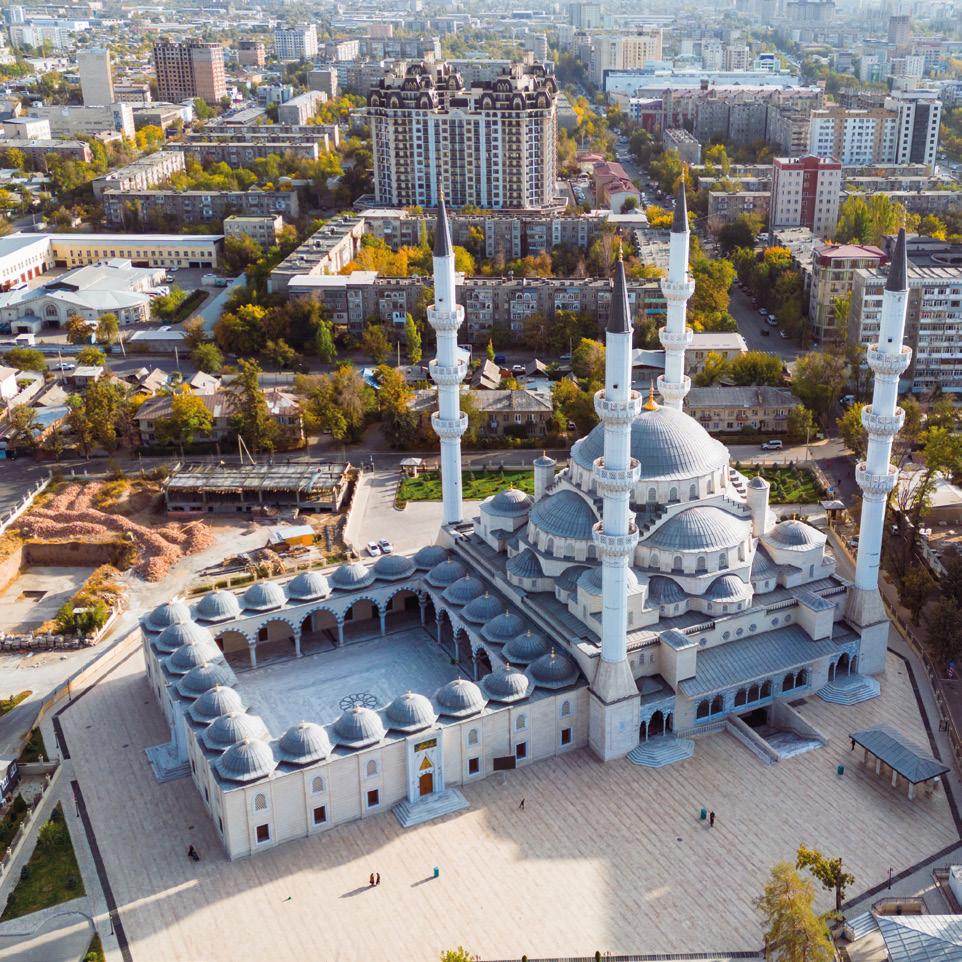






 Budapest
Graphic design: Alexandra Érsek-Csanádi,
photos: iStock
Budapest
Graphic design: Alexandra Érsek-Csanádi,
photos: iStock
LET’S BE HONEST, KYRGYZSTAN IS NOT WHAT POPS TO ONE’S MIND WHEN PLANNING A HOLIDAY TRIP. YET THIS HIDDEN GEM OF CENTRAL ASIA REALLY SHOULD.
The country that once was an important section of the ancient Silk Road – which by the way, can become one of the most popular touristic routes in the near future – bares an impressive cultural heritage of nomadic traditions and history that can offer the visitors a wide range of adventures, recreation opportunities and a stunning gastronomic experience.
Kyrgyzstan has it all: the mighty rims of the Tian Shan and the Pamir mountains cross the countries
landscape, fast rivers run through rocky gorges down to the valleys and alpine lakes spread on the highlands, providing a number of opportunities for active sports and recreational purposes.
The terrain that is crossed by numerous rapid streams and rivers makes Kyrgyzstan a popular destination for whitewater rafting.
Lake Issyk-Kul is the world’s second-largest alpine lake and something that the people of Kyrgyzstan are extremely proud of. Visitors can indulge in swimming, sailing, fishing, and even hot spring bathing along the lake’s picturesque shores.
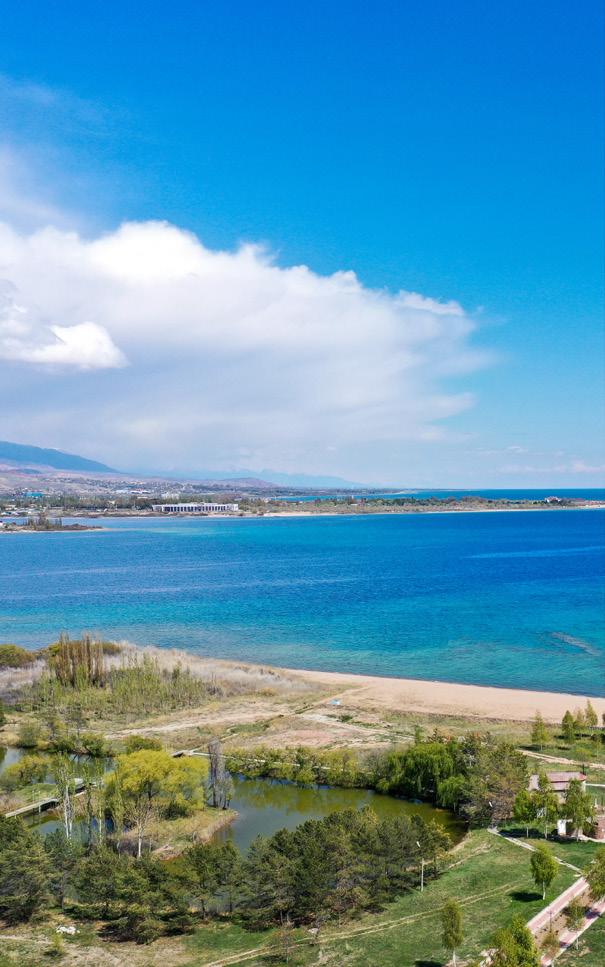
Kyrgyzstan combines outdoor activities with cultural heritage as it lies at the crossroads of the historic Silk Road trade route, which connected East

Asia with Europe. The Silk Road’s influence can be seen in the cultural heritage, traditions, and craftsmanship of Kyrgyzstan.
Probably the best thing about the touristic options in Kyrgyzstan is probably the fact that you can combine it all, there are plenty of tours that lead to the mountain passes, that include the cultural sites and are being done on horseback, on foot, off-road cars (or motorcycles by choice) and even river rafts to provide the most complex experience.
Whether a coincidence or not, the locals often refer to Kyrgyzstan as the Switzerland of Central Asia, or at least this is the level that they would like to reach, which is quite a noble title to bear.


The author is a researcher at Eurasia Center
Almost 90 per cent of the territory of the county is covered by mountains, three of the highest ones reach over 7000 metres, while there are still more than 30 peaks above 6000 metres, and more than 40 summits are over 5000 metres.

Publisher: Princeton University Press
Publication date: 2011
ISBN: 9780691150345
Pages: 512
With his excellent and thorough knowledge, Christopher I. Beckwith, Professor of the Department of Central Eurasian Studies at the University of Bloomington, presents the reader with the entire history of Central Eurasia from ancient times to the present. He delves into the origins, history, and significance of the empires along the Silk Road, as well as the origins of the region itself.
In addition, Beckwith shows the reader the history of the emigration of peoples from the region he calls Central Eurasia. The author describes in detail the economic foundations of pre-modern Central Eurasia and the occupation of the region by the Russian Tsarist Empire in the 18th and 19th centuries, as well as the world-historical significance of the partial and gradual revival of the peoples living here after the collapse of the Soviet Union.
Kathleen CollinsPublisher: Oxford University Press
Publication date: 2023
ISBN: 9780197685068
Pages: 584
In her new book, Politicizing Islam in Central Asia From the Russian Revolution to the Afghan and Syrian Jihads, Kathleen Collins provides an extensive overlook of the Islamist movements in Kyrgyzstan, Tajikistan and Uzbekistan by first examining the politicisation of Islam as such during the Soviet era, which gave ground to the mobilisation of the Islam and emergence of Islamism in the region.
The research is based on a strong source basis and a wide range of oral histories, interviews with religious leaders, Islamist movement activists and regular citizens of the examined states, providing a comprehensive understanding of the region and the roots of its issues. The author is an Associate Professor of Political Science and an Affiliate Faculty of Islamic Studies at the University of Minnesota.

Our recent volumes:

MATOLCSY GYÖRGY Olvasó–Napló I–II.

OZAN VAROL Gondolkodj úgy, mint egy űrkutató!

ELIZABETH KOLBERT Fehér Ég alatt CSIZMADIA NORBERT Geovízió I–II.

 by Szabolcs Veres
by Szabolcs Veres
STATE SYMBOLS ARE ONE OF THE ESSENTIAL ATTRIBUTES OF ANY STATE, EMBODYING ITS IDENTITY AND SOVEREIGNTY. IN THE REPUBLIC OF KAZAKHSTAN, THE STATE SYMBOLS ARE THE STATE FLAG, THE STATE EMBLEM AND THE NATIONAL ANTHEM.
The Kazakh flag was created by Kazakhstan’s honoured artist Shaken Niyazbekov. His design is a blue canvas with the golden sun in the centre above a soaring eagle with a traditional vertical ornament nearest the flagpole. The sky-blue colour can be interpreted in a number of ways. It symbolises honesty, faithfulness and flawlessness. It is also a reference to the ancient Turks’ tradition of worshipping the sky. The sun on the flag embodies wealth, abundance, life and energy, while the soaring steppe eagle illustrates the power of the state, its sovereignty and its aspiration for high goals and a sustainable future.
The central figure on the national emblem is a shanyrak, the round crown at the top of the Kazakh yurt that for centuries stood as the symbol of a common home uniting all the people of the country. Just as the strength and stability of the shanyrak depend on the reliability of all its yuks (pillars), the sustained development of Kazakhstan depends on the well-being of every citizen. Tulpars, the mythical winged horses, embody concepts like courage, loyalty and strength. The wings symbolise the long-standing dream of the multinational people of Kazakhstan to build a strong and prosperous state. The golden wings represent the diligence of the Kazakhs and the material well-being of the country.
The national anthem was adopted twice in the history of independent Kazakhstan, first in 1992, then in 2006. The latter version is based on a popular patriotic song, “Menin Kazakhstanym” (My Kazakhstan), written in 1956 by composer Shamshi Kaldayakov to the lyrics by Zhumeken Nazhimedenov. It was first performed on January 11, 2006, during the inauguration of the Head of State. Interestingly, the first President of Kazakhstan, Nursultan Nazarbayev, contributed to altering the song’s original lyrics.
The author is a researcher at Eurasia Center
 Photo: AFP/Anadolu Agency, Mehmet Eser
Photo: AFP/Anadolu Agency, Mehmet Eser
 by András Kosztur
by András Kosztur
AFTER 1991, AS A „NEWLY INDEPENDENT STATE”, KAZAKHSTAN ALSO HAD TO FACE THE QUESTION OF HOW TO EVALUATE ITS OWN PAST, HOW MUCH TO KEEP OF ITS SOVIET LEGACY, AND WHAT UNDERLINED FROM THE TIMES BEFORE
THAT. INSTEAD OF A RADICAL BREAK, THE KAZAKH LEADERSHIP IS GRADUALLY TURNING MORE AND MORE TOWARDS THE NATIONAL PAST WITHOUT TRYING TO ERASE THE MEMORIES OF THE RUSSIAN AND SOVIET PERIODS.
In recent years, the country’s steppe heritage has played a prominent role in Kazakhstan’s memory policy. In the historical self-image of the country, the Andronovo culture of the 2nd millennium BC has a dedicated place, the Bronze and Iron Age cultures, the history of the Silk Road that also touches today’s Kazakhstan, the Turkic Khaganate, which existed in the second half of the 1st millennium BC, or the period of the Mongol conquests, described as the first state formation in the region.
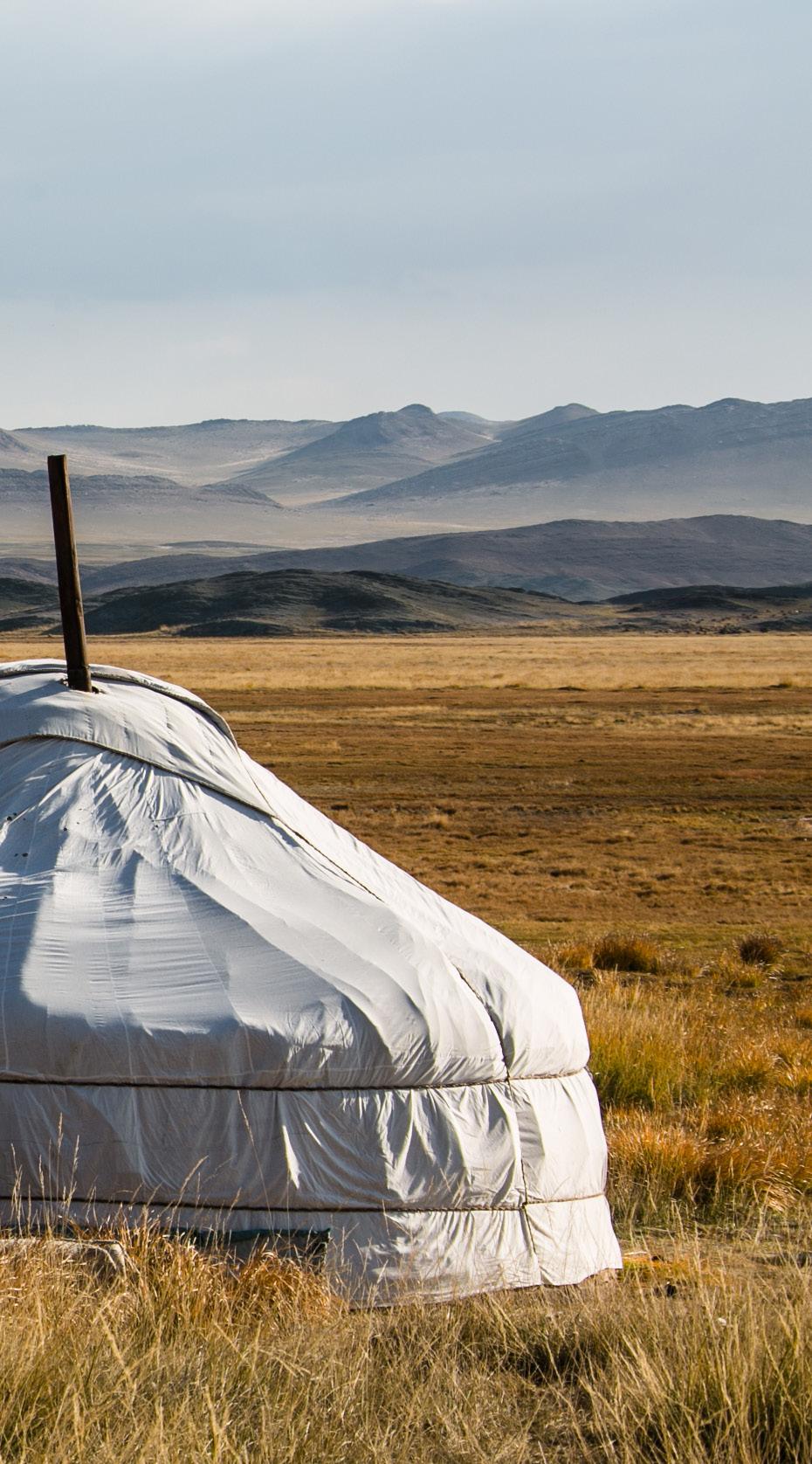
The actual Kazakh history begins after the fall of the Mongol Golden Horde when the formation of

the three groups (Zhuz) of the Kazakh identity took place. The 17-18th century was defined by the battles with Dzungaria, located further to the east, while in the 19th century, the area was already under Russian rule, which was followed by the creation of modern Kazakh statehood within the Soviet framework in the 20th century.
Establishing a relationship with the distant past is basically easier; the more difficult task was and still is the (re)interpretation of the Russian imperial and Soviet periods. The history of the 1920s and 1950s repressions play a particularly important role in Kazakh history, the day of which is commemorated every year on May 31. The repressions affected a significant part of the Kazakh national political and cultural elite.
Nonetheless, the Kazakh national (minority) policy tries to emphasize the ideas of acceptance and peaceful coexistence in relation to the events of these times, placing mutual assistance in times of trouble at the centre of historical memory. The Day of Gratitude national holiday, celebrated on March 1 – which was introduced in 2016 – aims to emphasize that the people of Kazakhstan are grateful to each other and underlines such qualities of Kazakhs such as patience, hospitality and peaceful coexistence.
The author is Senior Researcher at 21st Century Institute, he was able to conduct research in Karaganda within the framework of the exchange programme between the Foundation for Research on Central and Eastern European History and Society and Karagandy Buketov University.
ISSN 2939-8789 (Online)
ISSN 3003-9339 (Print)

Published by Neumann Lapkiadó
és Kommunikációs Kft.
Publisher's Headquarters: 1117 Budapest, Hungary, Infopark sétány 1.
Responsible Publisher: Levente Horváth, Ph.D., Managing Director
Editor-in-Chief: Levente Horváth, Ph.D.
Managing Editor: Mariann Őry, Péter Petán
Text Editor: Erika Koskocki
Editor: Joakim Scheffer
Photo Editor: Róbert Hegedüs
Graphic Design and Layout: Alexandra Érsek-Csanádi, Anita Kónya
Eurasia Magazine Online Editorial Board
Members:
Ágnes Bernek, Ph.D., László Csicsmann, Ph.D., Norbert Csizmadia, Ph.D., Mózes Csoma, Ph.D., Prof. Zoltán Dövényi, Ph.D., Béla Háda, Ph.D., Prof. Imre Hamar, Ph.D., Eric Hendriks, Ph.D., Prof. Judit Hidasi, Ph.D., Dr. Máté Ittzés, Ph.D., Péter Klemensits, Ph.D., Kristóf Lehmann, Ph.D., Csaba Moldicz, Ph.D., Prof. Erzsébet N. Rózsa, Ph.D., Borbála Obrusánszky, Ph.D., Prof. József Popp, Ph.D., Sándor P. Szabó, Ph.D., Prof. Zsolt Rostoványi, Ph.D., Gergely Salát, Ph.D., Péter Szatmári, Ph.D., István Szerdahelyi, Ph.D., Prof. István Szilágyi, Ph.D., Prof. István Tarrósy, Ph.D., Prof. István Tózsa Ph.D., Prof. László Vasa Ph.D., Zoltán Wilhelm, Ph.D., Alexandra Zoltai
If somebody wants to understand who the Uzbeks are, if somebody wants to comprehend all the power, might, justice and unlimited abilities of the Uzbek people, their contribution to the global development, their belief in future, he should recall the image of Amir Temur.
Islam KarimovKazakhstan is so large in area that people living on the western border are closer to Vienna than they are to Almaty, the country's previous capital.
Copyright :
All rights of use of the databases of Eurasia Magazine Online are granted to the Neumann Lapkiadó és Kommunikációs Kft. The written material and photographs used on this website are protected by copyright. They may not be published, broadcast or transmitted in any form or by any means, or stored in whole or in part on a computer, whether in their original or transcribed form.
SCAN ME!
